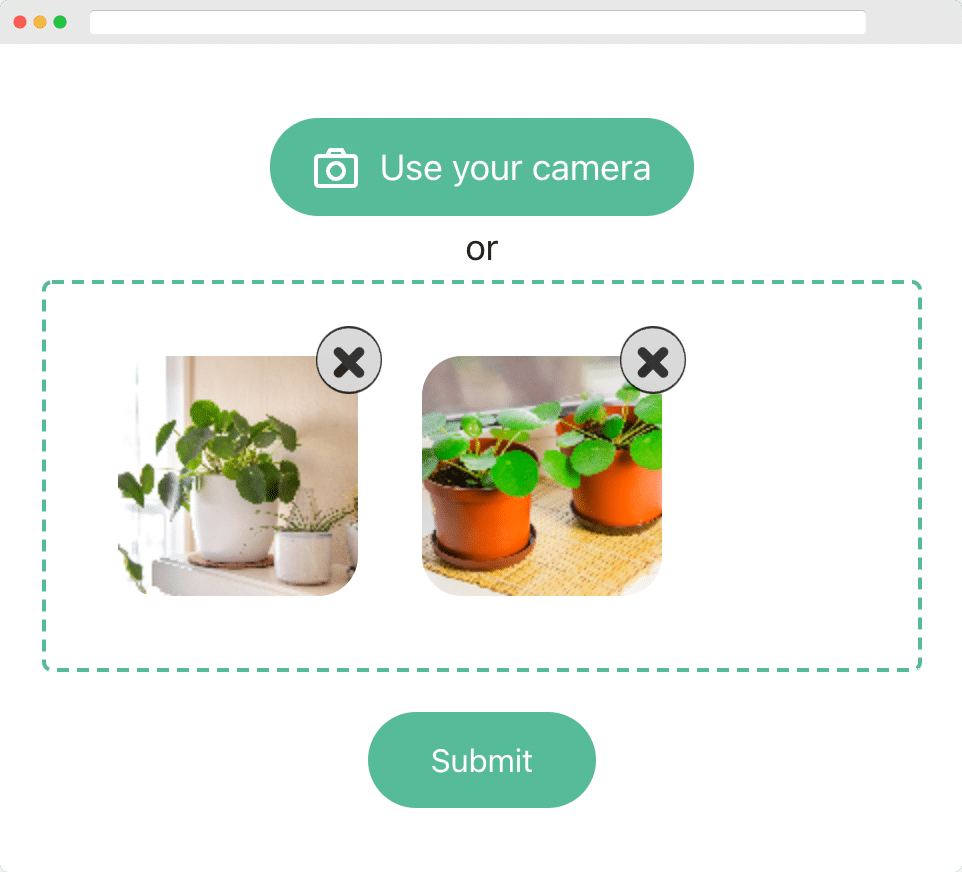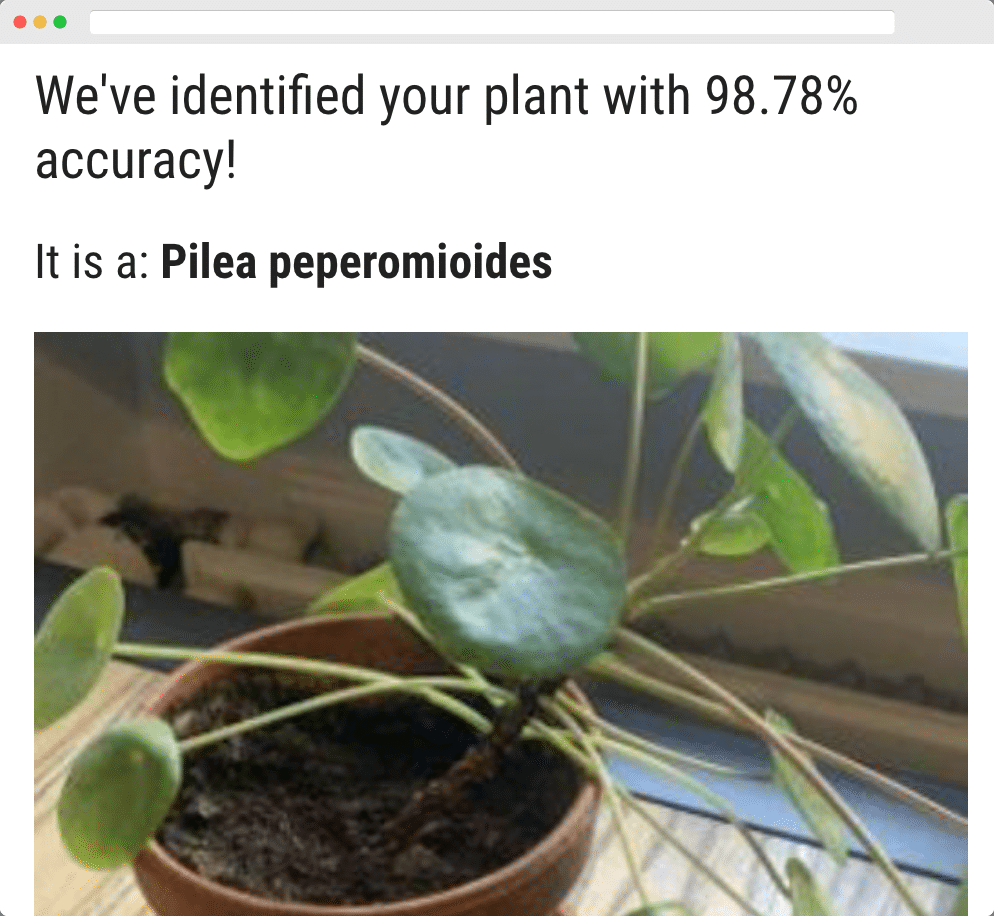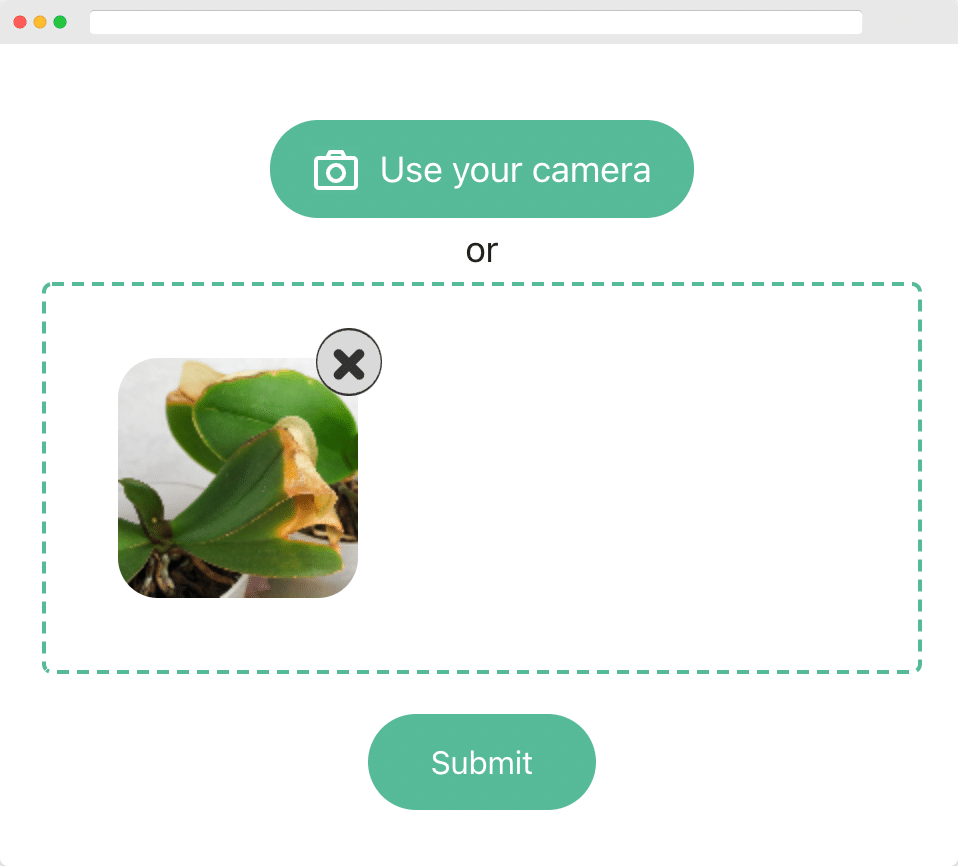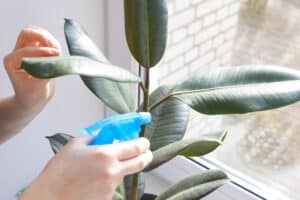Houseplant Identification Tool
Our houseplant identification tool will help you figure out the species of any houseplant with just an image.
Make sure to also join our houseplant community forum to discuss everything plant related with other readers!
We've identified your plant with % accuracy!
It is a:
More details:
Common names:
Name Authority:
Taxonomy:
Synonyms:
How It Works
Simply upload a picture of your plant and let our tool do the work. We can identify over 12,000 plant species from across the world!
For best results, try to upload multiple pictures. You’re much more likely to get an accurate results if you provide a few pictures for us to reference.


Powered by AI
This tool uses state of the art machine learning algorithms to ensure the most accurate results possible.
We estimate that our ID tool can correctly identify houseplants in 90% percent of cases. For best results, try to upload multiple pictures from different angles.
Coming soon...
Plant Health Assessment
Need help identifying an issue or disease that is killing your plant? We can help with that!
Just upload a picture of the affected plant and get a full assessment including tips to help nurse your plant back to health.

Houseplant Identification Tips
Whether you just bought a new plant and realized it didn’t come with a label or you need a little help remembering the name of the plant you added to your collection years ago, identifying your houseplants is an important part of keeping plants. Knowing what plants you have in your collection is certainly interesting but being able to correctly identify your plants can also help you understand their specific care requirements, such as their lighting and fertilizing needs.
Today, there are thousands of different species of houseplants, which can make the thought of plant identification a bit intimidating. Thankfully, there are some simple tips that can simplify this process, and useful tools, like free plant identification software, that can take all of the guesswork out of identifying any unknown plant.
Why It’s So Important to Correctly Identify Your Plants
If you have friends over and they ask you about your houseplants, it can give you a major boost of self-confidence to know that you can discuss your plant collection expertly and with ease. But the importance of correctly identifying your plants goes way beyond that.
Plant identification can help you determine what plants you have in your collection so you can provide the proper care requirements, such as watering and fertilizing schedules and lighting needs, that specific species need. Beyond that, some plants are known to be quite toxic, so plant identification can be a matter of health concern as well, particularly if you have small children or house pets that may take a nibble out of your plants.
How to Identify Your Houseplant
Careful observation is key when it comes to plant identification. Take note of any notable characteristics of the plant you would like to identify, such as plant size, growth habit, leaf shape and flower color. Fuzzy leaves, for example, are one of the most telltale characteristics of African violets, while crown-of-thorns (Euphorbia milii), as the name implies, have notably thorny stems.
Once you have identified your plant’s unique characteristics, it’s time to take some photos and get started identifying your plant.
Simplify Plant Identification With Plant ID Tools
Once upon a time, when houseplant keepers wanted to identify their mystery houseplants, they would have needed to take a trip to their local library and peruse countless books on houseplants, carefully comparing grainy photos to their unknown plant. Today, with the help of technology, plant identification has never been easier and more accurate. Online searches, phone apps and plant identification websites have made it super simple to figure out what plants you have from the comfort of your living room.
Just Houseplants has our very own free Houseplant Identification Tool that works on any computer or smartphone and can determine what plants you have in a matter of seconds. Relying on state-of-the-art machine learning (also known as artificial intelligence), our identification tool will compare the photos of your plant to the over 12,000 houseplant species in our database to produce search results in a matter of seconds. With an over 90% accuracy rate, our tool can take all the hard work out of plant identification.
Using Our Houseplant Identification Tool
To begin, you can take photos of your plant directly with your smartphone or computer or upload photos you’ve already taken into the identification tool. Try taking photos of any distinguishing characteristics of your plant, such as leaf color and shape, growth habit and flower size and coloration. While our search tool has an accuracy of over 90%, to improve your search results, try uploading multiple photos of your houseplant from different angles. And, of course, aim for quality photos that are not blurry or overly pixelated for better results. After uploading your photos, click “Submit,” and let our tool do the rest.
In a few seconds, our tool will identify your plant and provide you with some important information about it. Your search results will include the estimated accuracy of your search result (clearer photos produce more accurate results), as well as the common name and scientific name of the plant, photos for comparison and a bit of information about your plant species, such as country of origin, growth habit and species variation.
While our identification tool is very accurate, for added certainty in your identification, try double checking your search results with an internet search for the scientific name of the plant you identified. Comparing your plant to the search image results should give you that extra boost of confidence in your plant identification. Search results will also provide you with the specific care requirements and toxicity information for your particular plant species to help you ensure you’re meeting the care needs of your mystery houseplant.
Once you’ve identified your plant, you can give yourself a good pat on the back. With the help of our ID tool, it really is that easy!
Try to ID Your Plant With an Internet Search
If you don’t have a camera handy or the ID tool gives you unclear results, you can try identifying your plant with an internet search. Take note of the characteristics that make your plant unique and try using those terms in your search query. Some of the terms to search for include:
- Some ways to describe your leaves, including references to leaf color, shape, texture, and size, such as:
- Simple, lobed or compound leaves
- Heart-shaped leaves, star-shaped leaves, oblong leaves, etc.
- Broad leaves, large leaves, tiny leaves, etc.
- Smooth and glossy leaves or fuzzy leaves
- Purple leaves, variegated, striped, spotted, red-edged leaves, etc.
- References to plant flowers, including terms such as:
- Globe-shaped, cross-shaped, star-shaped, tubular, etc.
- Flower color, including bi-colored blooms
- Fragrance notes, such as honey-scented, fruit-scented, etc.
- Bloom-time, spring, summer or fall (this is important for plants like Christmas cacti that bloom at a particular time of the year)
- Size and number of blooms (bromeliads, for instance, only produce a single bloom, while spider plants produce a multitude of blossoms)
- Growth habit, such as:
- Trailing, upright, tall, vining, or low and mounded
- Plant variety, like:
- Succulent, cacti, tropical plant, herb, etc.
When conducting a search result on your own, try using as many of these descriptive words as possible to improve your search results. It can also be helpful to compare your plant to plants you already can identify by using search queries such as “daisy-like flower that smells like jasmine” or “plants similar to pothos with black leaves.” And be sure to include the term “houseplant” in your search query to eliminate any outdoor and wild-growing plants from your search results.
It can also help if you keep in mind that many plants in a single family have similar characteristics. This means that if you can correctly identify one plant and see commonalities in your mystery houseplant, you may be well on your way to correctly identifying your plant. For instance, if you know what a common aloe (Aloe vera) looks like and your mystery plant has similarly fleshy leaves with tiny spikes, you know there is a potential that you have some variety of aloe on your hands. Doing a brief search for “different aloe varieties” and comparing their differences can help you determine which variety of aloe you have.
While internet search engines are not a surefire way to identify your plant, by understanding how to use search keywords effectively and by carefully comparing photos, you can usually correctly identify your plant with just a little bit of legwork. If you’re having difficulty, try different search engines, or browse the pages of dedicated houseplant websites, such as Just Houseplants, to gain more insight about your mystery plant.
Consult Online Groups and Forms
If all else fails, there are many houseplant communities that are more than happy to help you with plant identification. Facebook, in particular, has many dedicated houseplant groups, where you can simply upload photos of your houseplant and their members will help you not only with identification, but also with common care tips requirements. The advice you receive from groups like this can be quite helpful as it is often based on the firsthand experience acquired by members. Advice can include specific answers such as fertilizing requirements, how to treat and prevent common pests and how to encourage your plant to bloom.
If you’re in the search for a houseplant group to help you identify your mystery plant, check out these groups, which boast both a large membership and a very active following:
- Facebook: Houseplant Addicts
- Facebook: Houseplant Hobbyists
- Facebook: Houseplants by gardenstead
Conclusion
Correctly identifying your houseplants is an important step in becoming a true houseplant enthusiast and a skilled houseplant keeper. Identifying your plants not only helps you determine plant safety with regard to household pets and small children, but it can also assist you with pinpointing the steps you need to take to keep different species of plants healthy for years.
While houseplant identification was once a tedious task, with the advent of internet technology and, specifically, useful software like plant identification tools, it’s never been easier. All you need is a camera, a few clear photos and the ID tool will do the rest. Next time you need to identify a plant, give our identification page a try and you’ll see how quickly you gain confidence with houseplant identification and care.
Read The Blog

How to Use Neem Oil for Plants: Natural Pest Control
In this guide we teach you how to use neem oil on your houseplants to get rid of pests, fungus, and other issues the all-natural way!

Repotting Spider Plant: Step-by-Step (With Pictures)
In this step by step guide we teach you how to repot spider plants with pictures to guide you along the way.

10 Reasons Why Your Spider Plant Has Yellow Leaves (and How to Fix It)
In this guide we cover 10 potential reasons why the leaves of your spider plant leaves are turning yellow and how to fix them.

Rice Water for Plants: Helpful or Harmful?
In this article we dive into the potential benefits and risks of using rice water to water your houseplants.

10 Reasons Why Your Peace Lily Has Brown Leaves (and How to Fix It)
In this guide we cover 10 potential reasons why the leaves of your Peace Lily are turning brown and how to fix them.

Feeding Carnivorous Plants: Step-by-Step Guide
In this step-by-step guide we teach out how to feed different types of carnivorous plants such as venus fly trap, sundews, and more.

Repotting Christmas Cactus: Step-by-Step Guide
In this guide we teach you everything you need to know about repotting a Christmas Cactus with detailed pictures to guide you along the way.

Alocasia Dragon Scale Care Guide (2023)
In this guide we cover everything you need to know about Alocasia Dragon Scale care including lighting, watering, and more.

Repotting Philodendron: Step-by-Step Guide (With Pictures)
In this step by step guide we cover everything you need to know about repotting Philodendron plants with pictures to guide you along the way.

Scindapsus Pictus ‘Silvery Ann’ Care Guide (2023)
In this guide we cover everything you need to know about caring for Scindapsus Pictus ‘Silvery Ann’, also know as the Silvery Ann Pothos.

Imperial Red Philodendron Care Guide
In this care guide we cover everything you need to know about keeping the stunning Imperial Red Philodendron in your home.

White Princess Philodendron Care Guide
In this care guide we teach you everything you need to know about keeping the stunning White Princess Philodendron at home.

Philodendron Black Cardinal Care Guide
In this care guide we teach you everything you need to know about keeping the unique and beautiful Philodendron Black Cardinal plant.

Rhaphidophora Hayi (Shingle Plant) Care Guide
In this guide we teach you how to care for Rhaphidophora Hayi, covering important topics such as watering, lighting, and more.

How to Use Moss Poles for Houseplants (With Pictures)
In this guide we teach you how to use moss poles for your vining houseplants with a detailed step by step guide and pictures.

15 Big Leaf Plants to Keep Indoors
In this guide we teach you how to keep 15 types of large leaf houseplants that will make a huge statement in your home.

Philodendron Micans Care Guide
In this guide we cover everything you need to know about Philodendron hederaceum ‘Micans’ including watering, lighting, and more.

Philodendron Erubescens (Blushing Philodendron) Care Guide
In this guide we cover everything you need to know about Philodendron erubescens care including water, lighting, and more.

Pothos Aerial Roots: What They Are and How to Manage Them
In this guide we cover everything you need to know about pothos aerial roots, what causes them, and how you can manage them the right way.

Syngonium Pink Splash Care Guide
In this guide we cover everything you need to know about keeping Syngonium Pink Splash including all care requirements.

Philodendron Rugosum Care Guide
In this guide we cover everything you need to know about Philodendron rugosum care including lighting requirements, watering, and more.

Shampoo Ginger Lily Care Guide
In this guide we cover everything you need to know about Shampoo Ginger Lily care including watering, lighting, and more.

String of Pearls Plant Care Guide
In this guide we cover everything you need to know about String of Pearls care including watering, lighting requirements, and more.

Raindrop Peperomia Care Guide
In this guide we cover everything you need to know about keeping Peperomia raindrop including water requirements, lighting, and more.